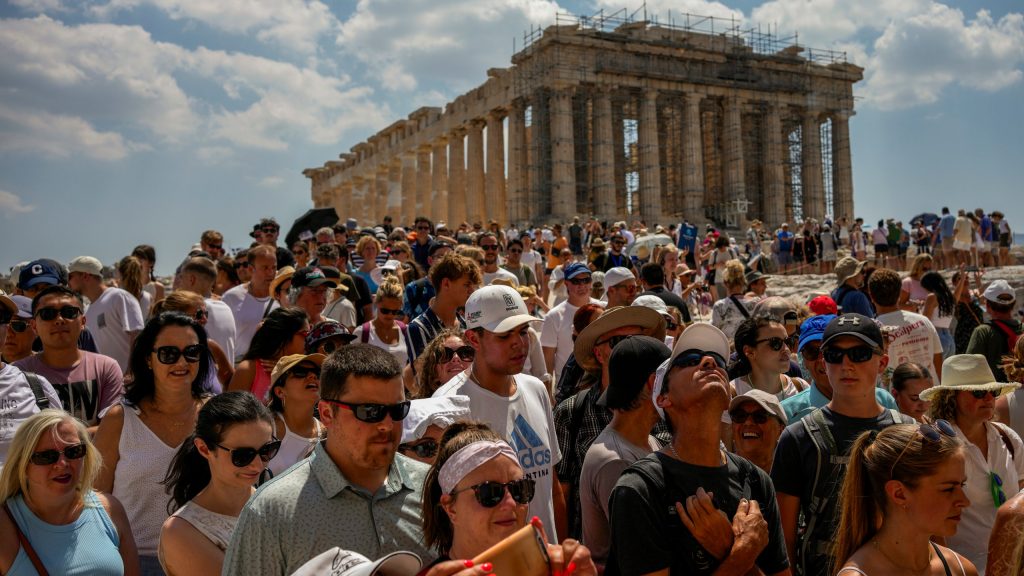Managing the Influx: A Cap on Acropolis Visitors
As Europe embraces the summer tourism surge, Greece stands at the crossroads of preserving its rich archaeological heritage and managing the influx of eager travelers. In a significant move, the Greek government has declared that access to the world-renowned Acropolis in Athens will soon be capped at 20,000 visitors per day. This strategic decision comes as a response to the escalating concern of overcrowding and bottlenecks at the historic site.
Hourly Entry Limits: A Delicate Balancing Act
To ensure a more organized and enriching experience for visitors, the Acropolis will implement hourly entry limits, with the system set to take effect next month. The initiative aims to distribute foot traffic more evenly throughout the day, curbing the concentration of visitors during peak hours. This thoughtful approach is a crucial step toward enhancing both the monument’s preservation and visitors’ engagement with the iconic UNESCO World Heritage site.

Safeguarding the Monument: A Matter of Priority
Greek Culture Minister, Lina Mendoni, emphasized that the introduction of visitor quotas is primarily rooted in the necessity to safeguard the Acropolis. The site, steeped in historical significance, has borne witness to as many as 23,000 daily visitors – a testament to its global allure. However, this considerable footfall has raised concerns about potential harm to the monument itself. Mendoni underlines, “The measure will address the need to protect the monument, which is the main thing for us, as well as (improving) visitors’ experience of the site.”
Striking a Delicate Balance
While the importance of tourism to Greece’s economy is undeniable, authorities grapple with the task of harmonizing the benefits of tourism with the preservation of cultural treasures. Mendoni recognizes the complexity of the situation, acknowledging the desirability of tourism while striving to shield the Acropolis from excessive strain. The culture minister stated, “Obviously tourism is desirable for the country, for all of us. But we must work out how excessive tourism won’t harm the monument.”
/https://tf-cmsv2-smithsonianmag-media.s3.amazonaws.com/filer_public/48/80/4880ec47-f69a-4b37-9aed-24e63326a413/crowds.jpg)
Implementation and Future Prospects
The new entry limits are slated to be introduced on a trial basis beginning September 4, with the regulations set to become permanent on April 1, 2024. It’s important to note that there will be no constraints on the duration of visitors’ stays at the Acropolis, allowing them to immerse themselves in its historical grandeur at their own pace. Nevertheless, the regulations will distinctly affect those participating in guided tour groups and cruise ship excursions, who constitute around half of the daily visitors and generally spend an average of 45 minutes exploring the site.
A Balanced Schedule: Varied Quotas for Varying Hours
To ensure equitable access throughout the day, the Acropolis will adjust visitor quotas based on its opening hours, which span from 8 am to 8 pm. With a substantial proportion of visitors arriving between 8 am and noon, the allocation will be strategically distributed. For instance, during the first operational hour, 3,000 visitors will be granted entry, followed by 2,000 in the second hour, and varying numbers during the subsequent time slots.
Climate Concerns: The Impact of Heatwaves
While managing visitor numbers is a paramount concern, climate change has also emerged as a significant factor influencing tourism operations. Last month, Greek authorities temporarily closed access to several popular attractions, including the Acropolis, in response to an unprecedented heatwave. With temperatures soaring to a scorching 118°F (48°C), measures were taken to safeguard tourists, including the distribution of 30,000 bottles of water and the creation of shaded areas around the revered Golden Age temples.
In the pursuit of striking a harmonious balance between heritage preservation and flourishing tourism, Greece’s measured approach to regulating Acropolis visits serves as a compelling example of responsible stewardship of cultural treasures amidst a dynamic travel landscape.
Feature Image Courtesy: Kark
How Canaletto’s representation of Venice inspired present era landscape artists

Contributor





